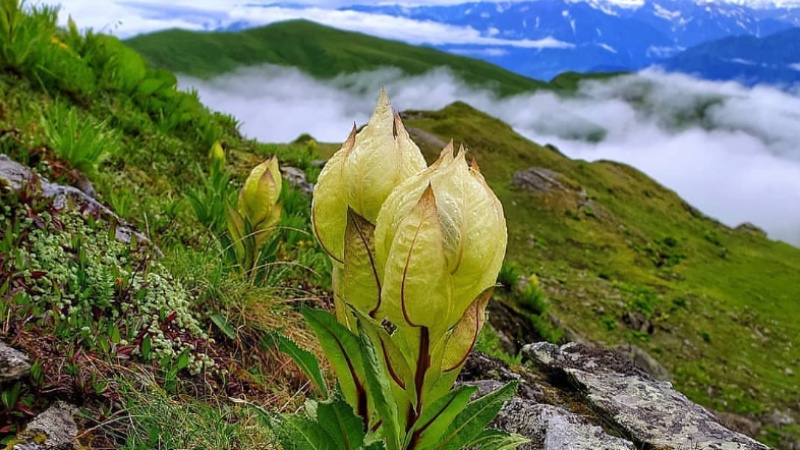Trending:
Brahma Kamal: Saving Uttarakhand's floral treasure
Brahma Kamal is a truly captivating flower, especially in its native high-altitude environment. With deep roots in mythology and traditional medicine, it holds a special significance, particularly among the local people in Uttarakhand.Shweta Sengar - Joshimath - UPDATED: July 26, 2024, 11:49 AM - 2 min read

Brahma Kamal - File Photo
If you happen to visit the Hemkunt Sahib gurdwara perched at over 4500 metres in Uttarakhand’s Nanda Devi National Park biosphere, consider yourself lucky if you get a glimpse of the famed “Brahma Kamal,” the elusive state flower.
The Brahma Kamal blooms on the wild slopes of the upper Himalayas in northern India and lasts only a brief period of time during the monsoon season.
The flower known locally as "Brahma Kamal" is now considered an endangered species and derives its name from its association with Lord Brahma, the creator of the universe in Hindu mythology. According to Hindu religious texts, Brahma was said to have emerged from a lotus blossoming from Lord Vishnu's navel, giving the flower its name.
Brahma Kamal is a truly captivating flower, especially in its native high-altitude environment. With deep roots in mythology and traditional medicine, it holds a special significance, particularly among the local people in Uttarakhand.
This exquisite flower, also known as Saussurea obvallata, is the state flower of Uttarakhand and is native to the Himalayan region, as well as certain parts of northern Myanmar and southwest China.

The Brahma Kamal plants often grow in clusters, resulting in groups of these beautiful flowers. Each plant can grow up to one foot in length. The flower usually blooms between July and August and can still be seen up to September or even early October. As winter approaches, the plant perishes, only to reappear around April. The flower emits a delicate yet captivating fragrance.
However, the flower is said to have been facing the perilous effects of climate change and exploitation by the locals, who pluck them in bunches and sell them to the tourists who want to have one.
The plant is known for its medicinal properties. Locals pick the plant extensively for traditional ayurveda medication preparation, in addition to its religious significance. The rhizomes, leaves, and petals are used to cure urinary tract issues, digestive disorders, coughs and colds, and bone pain. The rhizomes are particularly used as an antibacterial and to treat cuts and bruises.
This plant is now threatened because of increased human interference and exploitation.
“Numerous plants, including S. obvallata, are in danger of going extinct because of overuse. Therefore, it is crucial to protect all therapeutic plants. The main reason for the fall in its population is the overuse of the plant's parts for medical and religious purposes. Actions can be performed in a variety of ways to support the preservation and sustainable usage of medicinal plants. Others are less direct, such as those linked to commercial systems, ex-situ conservation, and in situ conservation, while some of these are carried out directly at the locations where the plants are found,” according to a report published in the International Journal of Pharmaceutical Research and Applications in 2023.
Conservation efforts to protect and propagate the Brahma Kamal have been going on for years.
Sanjiv Chaturvedi, IFS and Ramon Magsaysay Awardee, is actively working on projects to conserve Uttarakhand’s state flower.
“There are two ways to conserve and grow the flower – in-situ and ex-situ. In 2018, we tried ex-situ propagation and collected seeds of the Brahma Kamal from Bedni Bugyal in Uttarakhand. We tried to grow the flower at 2000 metres, well below its average growing altitude. The seeds germinated, and we replanted them elsewhere in a more suitable altitude, but the plants died within two months.”
Chaturvedi cites that the Brahma Kamal’s habitat is very specific, and they need a constant water source and snow for about four to five months. These are the key factors that make up the plant’s habitat.
Later, in 2019, Chaturvedi and his team tried to grow Brahma Kamal in Mana, which is a remote village at an altitude of 3500 metres in Uttarakhand. “We brought the rhizomes from high-altitude flowers and also brought the soil from there to Mana. The plants bloomed in June, and their size was much smaller than that of a typical Brahma Kamal flower.”
He said the plants are still there, but there has been no flowering for the past four to five years.
Chaturvedi said that the Brahma Kamal is a very elusive flower and grows in small numbers by “nature’s design.” “It doesn't grow anywhere and needs very specific weather and altitude to grow and thrive. We have noticed vegetative growth of the flower in many places – meaning there are only plants but no flowers.”
He also said that, due to limited research, it is extremely difficult to say whether the Brahma Kamal numbers are declining or increasing.
The medicinal plants described in traditional Indian literature have been used to treat illnesses since the Vedic period. The recent resurgence of interest in herbal remedies has resulted in the widespread exploitation of these medicinal plants from their natural habitats. The continuous process of desertification and uncontrolled grazing in the high-altitude Himalayan pastures poses a risk to the survival of several important medicinal plants, including Brahma Kamal.
Indiscriminate exploitation and illegal trade of plants or their parts as medicine or for other commercial purposes, illicit means of picking for worshipping, unchecked tourism and trekking with a complete lack of planning in eco-sensitive areas, and destruction of natural populations due to uncontrolled settlement construction are some of the factors that may have triggered the early extinction of these species.
